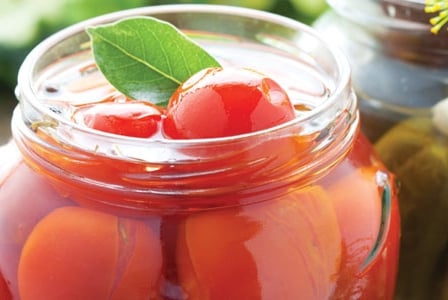
What Cleopatra knew over 2,000 years ago – and what food scientists know now – is that fermented foods confer important health benefits.
What Cleopatra knew over 2,000 years ago—and what food scientists know now—is that fermented foods confer important health benefits.
The ancient art of pickling involves preserving foods in acid. Two different methods of preservation are used, each with its own set of benefits.
Brine pickling method
In the days before refrigerators, someone who wanted a tangy sidekick for a sandwich might have opened a squeaky wooden door, gone down the back stairs, and entered a musty cellar where sour pickles bobbed in a barrel of brine, and sauerkraut sat stewing in an earthen crock.
These traditionally fermented foods required only the magic of salt in order to produce their own acids. When vegetables were immersed in a brine of 10 to 15 percent salt, sugars were drawn to the surface where they reacted with lactic acid bacteria. The end product of this chemical reaction was lactic acid, which gave the vegetables a mouth-puckering flavour and helped them last for weeks without spoiling.
Nowadays fewer of us have cellars, but healthwise it’s worth going out of our way to find fermented fare. The health advantages of fermented foods largely stem from their status as probiotics—foods that contain friendly live bacteria. Probiotics have been associated with better digestive health, reduced gastrointestinal tract inflammation, and protection against allergies.
People who regularly consume probiotics may also be less susceptible to bacterial infections, since the good bacteria crowd out the small amounts of pathogenic bacteria we all encounter from time to time. Recent research also suggests probiotics play a role in fighting colorectal cancer by enhancing the body’s immune response.
A pickled product that does not list vinegar on the label is a good probiotic candidate, provided it has not been heat-processed during production. Since cooking kills off the good bacteria, be sure to consume probiotic foods raw.
Vinegar pickling method
Today the most common way to preserve foods in acid is by vinegar pickling: instead of coaxing the vegetables into producing their own acid, the pickle maker simply immerses them in a vinegar (acetic acid) solution. This drastically inhibits the growth of pathogenic microbes and yeasts. Because it creates products that last almost indefinitely, this quick method is used for the vast majority of pickled foods you see on store shelves.
Foods preserved in vinegar are not probiotics, but they may have distinct health payoffs when eaten in moderation. One study found that consumption of acetic acid during a meal reduced postprandial spikes in blood sugar. Vinegar consumption has also been reported to improve diseases such as hypertension, hyperlipidemia, and obesity.
Choose natural vinegar
Vinegar is made by fermenting a variety of sources that contain carbohydrates and sugars. Fermentation of the sugars produces ethanol, which is then oxidized by acetic acid bacteria.
Read the label carefully when buying vinegar. Choose an all-natural source such as wine, cider, or fermented fruit juice. Avoid vinegars containing synthetic ethanol that’s derived from natural gas and petroleum products.
It’s time to open up that jar and add zip to your diet with these common pickled foods.
Recipes
- Tangy Sauerkraut Salad
- Steak Salad with Pickle-Pepper Dressing
Pickle it yourself
Alongside urban gardening and backyard chicken raising, pickling is undergoing a revival across North America. Here are some tips for getting started.
First-time fermentation
Few things are more satisfying than eating homemade kimchi on noodles or using your own fermented garlic to create a unique salad dressing. Most rookie fermenters start with a book such as Sandor Ellix Katz’s Wild Fermentation (Chelsea Green Publishing, 2003) or his DVD Fermentation Workshop (Chelsea Green Publishing, 2010). Local chefs may offer fermentation workshops.
Novice vinegar pickling
If you’re new to pickling, it’s a good idea to start with recipes that include vinegar, since they require less skill and produce more consistent results. Fall bumper crops can be turned into pickles. You can put pickled beans to use as cocktail stirrers or bring out a jar of pickled peaches to add Southern-style flavour.

